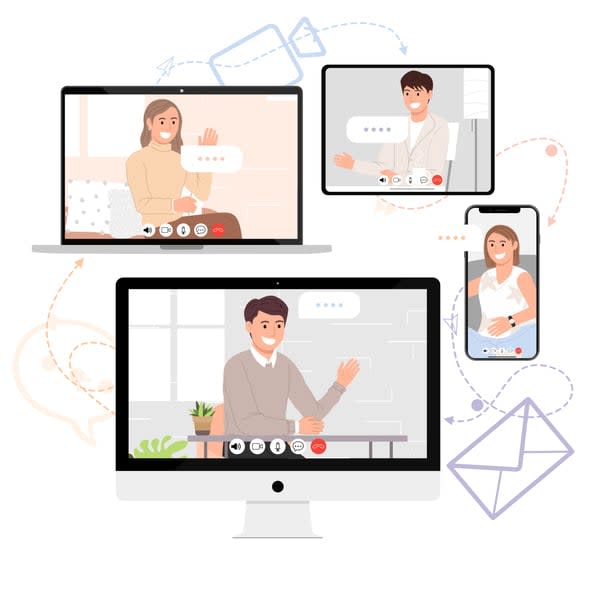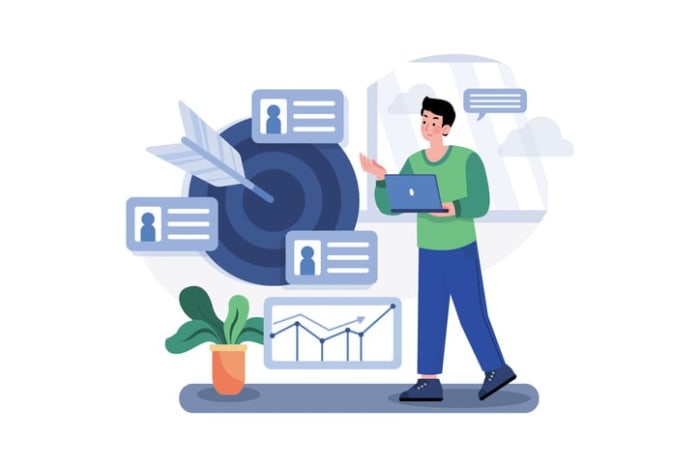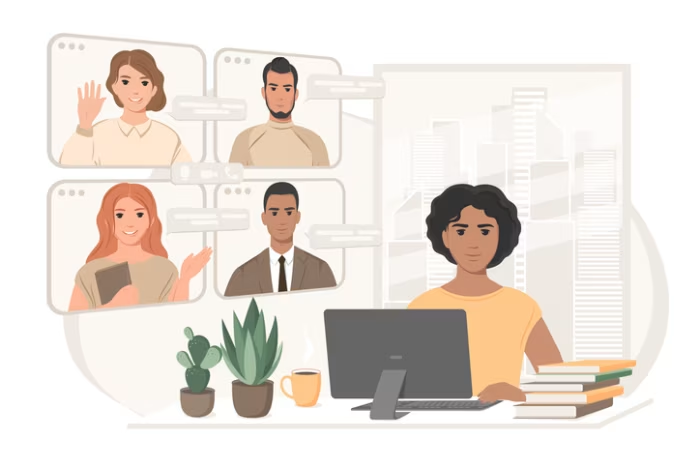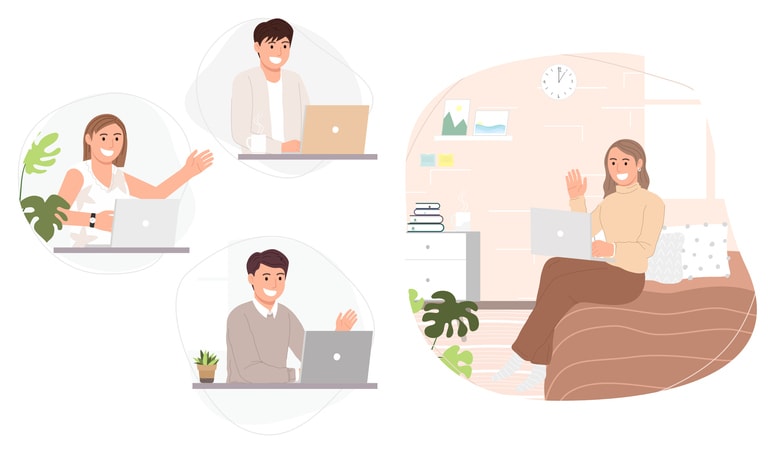Imagine being part of a team working on a fast-paced project with deadlines looming and tasks piling up. Amidst the hustle, there’s a need for a space to breathe, to talk, to connect beyond the professional facade. This is where Catch Up Meeting comes into play.
Short Summary
- Catch-up meetings are a great way to build trust and understanding between team members.
- Plan ahead & keep catch-up meetings short & engaging for busy schedules.
- Encourage open communication, use icebreakers / conversation starters, and give/receive feedback for personal growth.
Understanding catch-up meetings

Catch-up meetings are your oasis in the midst of the work chaos. They are casual get-togethers where team members talk about work, personal updates, and build better relationships with each other. They are different from regular meetings - they’re relaxed, friendly, and allow team members to express themselves without the pressure of a formal setting. Make sure to schedule your next catch up meeting to maintain this valuable connection with your team.
Catch-up meetings are a great way to build trust and understanding between team members. They are the greatest.
The importance of catch-up meetings
These seemingly casual meetings are the secret sauce to a high-performing team. They boost team communication, employee involvement, and keep the team morale high. They provide an opportunity for team members to receive feedback in a relaxed and supportive environment.
And listening, my friend, is the key to successful catch-up meetings.
Catch-up meetings vs. formal meetings

While formal meetings are all about business, catch-up meetings can be considered as the informal counterpart to a formal meeting, essentially serving as an informal gathering. They are chill, friendly, and focus on strengthening relationships outside of the usual team meetings.
In these meetings, team members can share their honest opinions without fearing judgment.
Planning and scheduling catch-up meetings

Catch-up meetings should be like a cup of coffee - taken regularly but not too much that it overwhelms you or adds to your day to day grind. Avoid overloading people’s busy schedules and keep the meetings concise and engaging.
Make sure to keep the meetings short and to the point. Ask questions to ensure everyone is on the same page.
Frequency and duration
How often should these caffeine shots of productivity be taken? Ideally, start with weekly or bi-weekly meetings and then adjust their frequency depending on how useful they are and how available everyone is.
This will help ensure that everyone is on the same page and that the meetings are productive and efficient.
In-person vs. remote catch-up meetings
Whether you prefer face-to-face meetings or virtual ones, one on one meetings, including catch-up meetings, can be tailored to fit your preferences. In-person meetings often happen in comfortable settings, while remote meetings offer convenience for remote teams spread out across geographical locations.
No matter which type of meeting you choose, it’s important to make sure that everyone is on the same page.
Creating a catch-up meeting agenda

While catch-up meetings are informal, having a meeting agenda template keeps the conversation focused and ensures that all important topics are covered. An agenda provides a roadmap to the meeting, setting expectations for all team members.
Having an agenda helps to ensure that everyone is on the same page and that the meeting is organized.
Essential talking points
Your catch-up meeting agenda should cover key topics like work-life balance, mental health, goals, and feedback. However, it’s not a rigid schedule. Leave some room for flexibility and personal updates to keep the conversation dynamic and engaging.
Balancing work-related and personal topics
A catch-up meeting is like a well-balanced diet. It should have an equal mix of work-related discussions and personal updates. This balance fosters a supportive and engaging atmosphere where team members can discuss their professional progress and personal well-being. Establishing a consistent meeting cadence ensures that these catch-up sessions remain effective and productive.
By having a mix of work and personal life topics, team members can feel comfortable sharing their successes.
Engaging team members in catch-up meetings

The success of effective catch up meetings lies in their ability to engage all team members. Encouraging open communication and using icebreakers or conversation starters can definitely make these meetings more interactive and engaging.
Icebreakers can be anything from a simple question to a game or activity. They help to break the rules.
Encouraging open communication
Open communication is the heart of a vibrant team. It builds trust and connection among team members, making collaboration more effective.
By encouraging open communication, you’re not just fostering an environment of trust, but also promoting a culture of transparency and honesty.
Icebreakers and conversation starters
Kickstart your catch-up meetings with fun icebreakers or conversation starters. They help set up a relaxed and friendly atmosphere, making it easier for everyone to express their thoughts and feelings during informal chats.
After all, who wouldn’t want to start a meeting with a round of “Two Truths and One Lie”?
Tips for hybrid and remote catch-up meetings
It’s often hard to create open and cross-organization communication when you have a distributed team. Everyone from large multinational corporations with office around the world and remote-first startups face this challenge. As the world adopts an increasing hybrid workplace, this challenge will only increase, even for mid-sized companies that might have all their employees in one single office.
Find communication tools that inspire burst communication
Burst communication is what happens in a physical workplace, often this can be referred to as watercooler conversations. Put another way, these are just unplanned catch-up meetings where employees bond and have casual conversations.
In a hybrid and distributed workplace its important to replicate this behavior, but most companies lack the communication tool to do so. Slack, Microsoft Teams, and Zoom are built for either asynchronous communication or planned formal meetings, and this does foster great catch-up meetings.
Invest in a virtual workspace platform
An increasing popular business communication tool is a virtual workspace platform. These tools can often replace Slack and Zoom within a company’s IT stack, resulting in significantly cost savings. Additionally, the benefits go far beyond financial.
Take Kumospace, the leading virtual workspace platform. Teams what use communicate report faster and more frequently meetings. Employees are able to easily have catch-up meetings that feel like organic watercooler moments rather than forced interaction. This is because the average Kumospace meeting is 9 minutes long and happens sporadically through the day, like it would in a physical office. This quick catch-ups strengthen bonds between employees which leads to better cross-team collaboration and productivity.
Giving and receiving feedback in catch-up meetings
Feedback is the breakfast of champions, and catch-up meetings serve this nutritious meal. These meetings provide the perfect platform to discuss feedback, leading to continuous improvement and a supportive work environment.
Feedback is essential for growth and development, both personally and professionally. It helps us to identify ourselves.
Constructive feedback
Constructive feedback is not about pointing fingers or assigning blame. It’s about identifying areas of improvement and providing specific, respectful, and helpful insights to help team members grow and improve.
It should be an ongoing process that encourages open dialogue and collaboration. It should be a safe space.
Receptive to feedback
While giving feedback is important, being receptive to feedback is equally crucial. Treat concerns with respect and show willingness to work together and support team members in their journey of growth and improvement.
It is essential to create an environment where everyone feels comfortable to give and receive feedback.
Maximizing the benefits of catch-up meetings

To squeeze the maximum juice out of your catch-up meetings, focus on strengthening team bonds and identifying areas for improvement. This can lead to increased productivity, job satisfaction, and a team that’s more like a family.
By taking the time to get to know each other better, teams can build trust and understanding.
Strengthening team bonds
Strong team bonds are like a safety net that catches us when we stumble. Regular catch-up meetings and open communication can help strengthen these bonds, creating a strong and cohesive team that’s ready to face any challenge together.
Teamwork is essential for success, and strong team bonds are the foundation of any successful team, with a team leader playing a crucial role in guiding each team member.
Identifying areas for improvement
Identifying areas for improvement is like tuning a guitar. It helps you adjust your approach, address any issues, and play a perfect symphony of productivity and efficiency.
FAQ
- Question: What’s the point of catch-up meetings? Answer: Catch-up meetings are like an oasis in the desert of work chaos. They provide a platform for open discussions about project updates and areas of improvement. They also help in strengthening team bonds.
- Question: How often and for how long should we have catch-up meetings? Answer: Catch-up meetings should ideally be held once a week and shouldn’t last more than an hour. However, this can be adjusted based on the team’s needs and availability.
- Question: Why should we have an agenda for catch-up meetings? Answer: An agenda for catch-up meetings ensures that all important topics are covered and keeps the discussion on track.
- Question: What are the benefits of catch-up meetings? Answer: Catch-up meetings can help build stronger team connections, foster open dialogue, and give team members a chance to give and receive feedback.
Summary
In a nutshell, catch-up meetings are like the friendly neighborhood Spiderman of the corporate world. They swing by to save the day, fostering camaraderie, facilitating open discussions, and boosting team productivity. They bridge the gap between team members, allowing them to catch up, connect, and collaborate effectively. So, when is your next catch-up meeting?
Frequently Asked Questions
A catch-up meeting is an informal get-together of team members and coworkers which is more relaxed and shorter in length than a formal meeting.
It is a great way to stay connected with colleagues, share ideas, and discuss any issues that may have arisen since the last meeting. It is also a great opportunity to catch up on any tasks that may have been missed or forgotten.
Let the person know in advance that you would like to catch-up, propose a time slot of 15 minutes and reassure them that it’s only for catching-up.
A catch-up meeting is an informal gathering of two or more people to discuss work-related matters. The conversation can include progress on projects, recent events in their personal lives, and other topics.
This type of meeting is meant to be relaxed and shorter in length.
A catch-up meeting is a short, relaxed chat to evaluate progress on current tasks and review workloads. Everyone present will discuss progress on projects, recent events in their personal lives, and all kinds of other topics, allowing for open and honest dialogue.
These meetings are a great way to stay connected with colleagues and build relationships. They can also help to identify any issues that may be preventing progress and provide an opportunity to brainstorm solutions.
Make the most out of your catch-up meetings by fostering team unity and open communication, and focus on identifying areas that can be improved to increase productivity and job satisfaction.
By creating an environment of trust and respect, team members can feel comfortable to share their ideas and opinions. This will help to identify areas that can be improved, and create a plan of action to increase productivity and job satisfaction.
Encourage teamwork.





